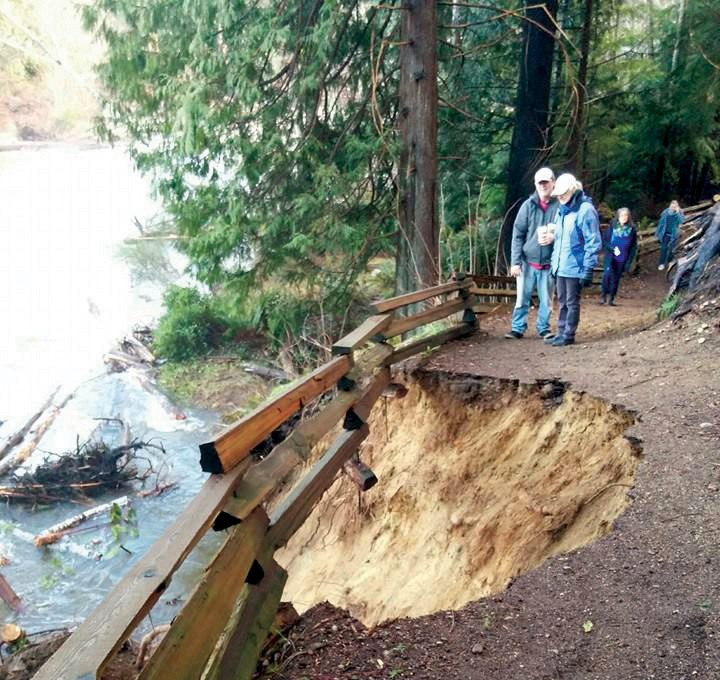Moving a popular trail well away from the banks of Chapman Creek may be the easiest way to protect it from erosion, according to a consultant hired by the District of Sechelt.
Dave Bates of FSCI Biological Consultants had already started his work when a winter storm system hit the area Jan. 21, washing away a section of the trail. He gave a briefing on his work so far at the Jan. 27 meeting of council’s public works, parks and environment committee.
Bates said the problem area at Brookman Park is one of the few along Chapman that hasn’t been “armoured” -– protected against erosion with engineered works such as rip-rap. He added that although the trail is being lost, it doesn’t show there’s a problem with Chapman Creek itself.
“The river is doing what the river wants to do,” Bates told the committee. “There’s nothing unusual given the constraints and the armouring that’s occurred at that particular point.”
Bates outlined a brief history of issues along the lower part of Chapman Creek, going back to a flood in the mid-1950s that reduced its future flood capacity and changed the floodplain.
The installation of the current bridge, also in the mid-50s, constricted the creek.
In the ’70s and ’80s and ’90s there were efforts to armour the creek banks by Big Maples Trailer Park, at a private property upstream from Big Maples, and near the bridge.
Bates explained that this “piecemeal” approach is at least partly responsible for the present-day problems.
“To fix the problem as we see it today, and to prevent any further encroachment, what we’re likely looking at,” he said, “is manipulation of the channel and a much heavier armouring scenario that will see the channel fixed and fixed for all time.”
He acknowledged, though, that it could be a large, costly and difficult task. Bates also added that if the district wants to keep the trail close to the creek bank, it will make the task that much more difficult.
“You’re either looking at something significant or moving the trail,” he said. “The trail is currently within the riparian area – a protected area. The district abides by the riparian area regulation under the provincial fish protection act and, in fact, the trail shouldn’t be within that 15- to 30-metre distance to the [creek] system. It’s just not a good spot for a trail and it’s going to require ongoing maintenance if, in fact, you can stabilize that slope.”
Bates said he recognizes it won’t be a popular idea.
There’s no firm date for Bates to come back with a final report, but he told the committee the solution he’s likely to suggest will be based on one his firm worked on in the ’90s.
“In 1997 we proposed a design that saw the constraining of the river, the armouring of the river, and the physical movement of the river using a soft engineering approach,” he said, adding that the 1997 concept will be updated using current data on Chapman Creek.
The committee voted to recommend that council ask, “That when the report comes forward on potential remediation of Brookman Park Trail and surrounding area, reference be made to impacts and opportunities on private property.”
Parks supervisor Perry Schmitt told the committee staff has already started the work of checking property lines and sketching out possible alternate routes for the trail.
Council was expected to approve the recommendation at its Feb. 3 meeting.



